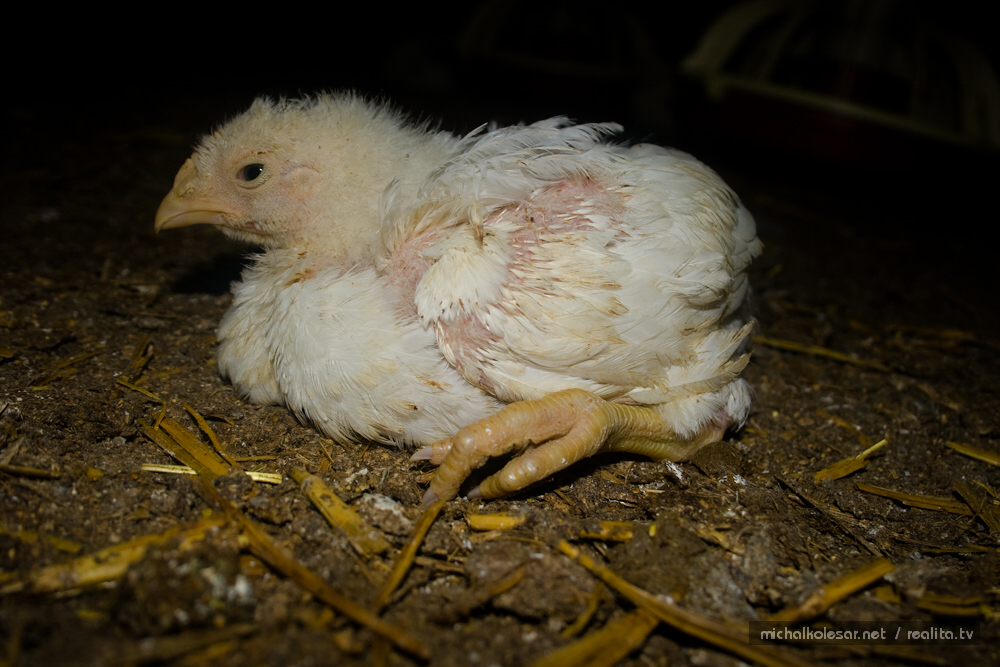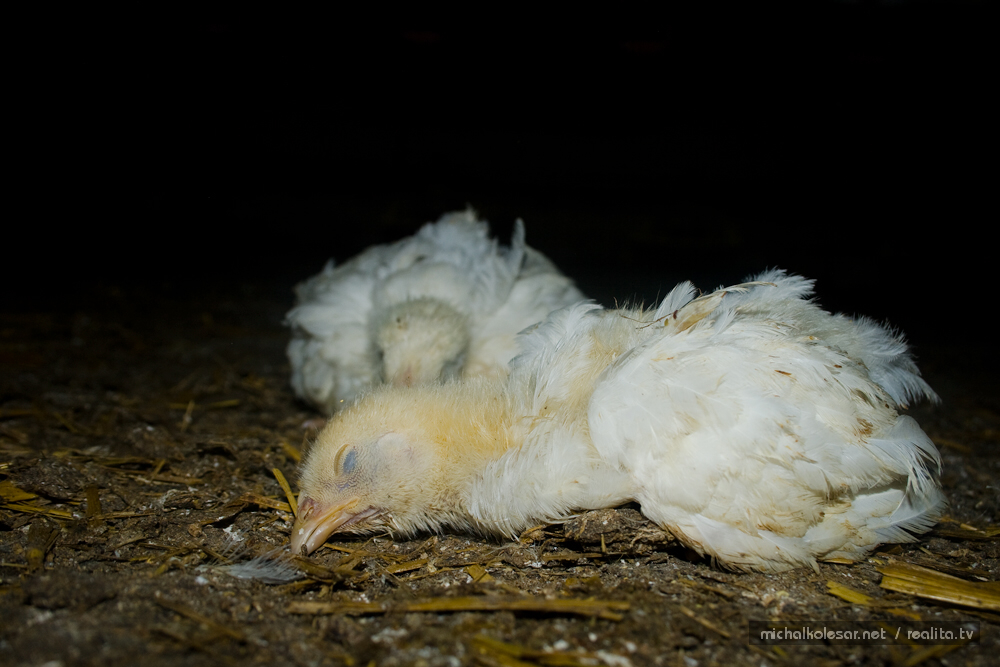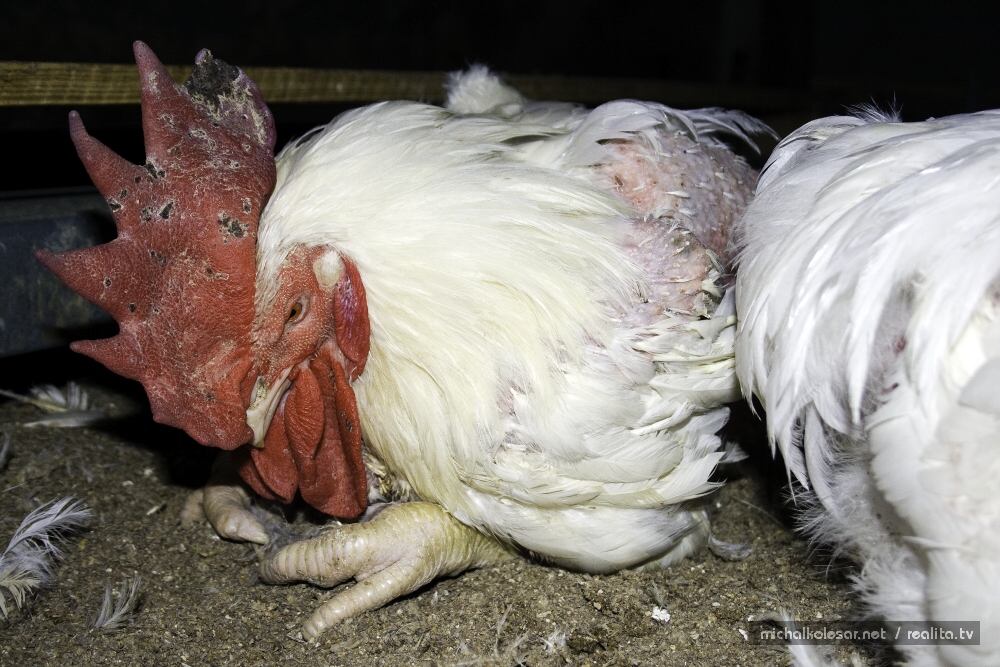Broilers: wretched babies

The keystone of the term broiler is a highly intensive fastfeeding of an immature body. Broilers are children whose muscles equal the weight of a grown-up while their skeleton and the inner organs remain childlike. The broiler industry is a purposeful cripple manufactory.
The word itself, broiler, comes from “to broil” - to prepare by grilling. It was first used in The USDA Annual Report in 1935. The veterans of a post-war Czechoslovak Socialist Republic might remember Czech equivalent of the word broiler - pečínkové kuře, roasty chicken.
People often say that if hens and broilers actually were in bad health conditions, they would not lay eggs respectively not put on weight. A mistake. By genetic selection, by manipulating with their living conditions and nourishment, including drug administration, it was accomplished that hens lay eggs and broilers put on weight in abnormal conditions. The results are: various deformations, ilnesses, permanent stress, hystery. The deformators have led the animals’ biological functions far over their physical abilities and at the expense of their health, so that the birds live constantly on the brink of collapse.
Birds with deformed limbs, skin, cardial and respiratory problems, crammed in artificially illuminated sheds with permanent noise from ventilation, obsessed with forced gluttony, which means they are constantly surfeited and hungry at the same time. Birds drag their crippled legs behind or along the body, sometimes move forward by flapping their wings, as if they were rowing. They also use wings to keep in balance when walking, which is what they in many cases wouldn’t otherwise be able to do. Immobilised chickens might not even reach the water and feed at all and die of hunger and thirst.
Abnormally grown breast muscles contribute to the unstability. Chickens are programmed to make this muscle large because from the business perspective, this is the most interesting part of their body. In the eighties, breast meat represented 10% of the average chicken weight, now it is 21%, says John Hardiman, geneticist from the corporation Cobb-Vantress in Siloam Springs, Arkansas. “I am sure we will reach 30%, which nears the present figure for turkeys,” Hardiman adds. (1)
Since motion disorders of the broiler chickens are mostly genetically determined, it is impossible to prevent them; they are yet worsened by the density of chickens in the shed. With too much of them on too little space, chickens cause wounds to each other when they try to crawl over the weak. Controlling their health conditions and collecting dead animals is also complicated, this is, however, never done anyway.
Insufficient hygiene in the sheds, wet or rotting bedding combined with motion handicaps, which force chickens to lengthy sitting, cause sores and ulcers on thier legs and chests. Chickens could live up to seven years, instead of this, many of them die before they are transported for slaughter at six weeks age. What do the people want to accomplish? To breed loafs of meat without feathers and bones? I think so.
By the end of October at the international poultry sabbat “Drůbež 2004″, Poultry 2004, in Brno, a claim well documenting the extremism of “livestock production” advocates was heard. Paul Gittins stated with regard to the fattening period of broiler chickens that, “it must be a sprint, not a marathon”.(2) He also voiced a hope that “the market with poultry has got a future”.(3) Poor chickens; they were called “a livestock of the future”.(4) What could be worse?
The standard fattening period of chickens, depending on their sex, is currently 39-42 days, during which the weight of birds rises from 32-44 g in the age of one day to the execution weight 1.8 to 2.2 kg (ROSS 308). In 1972 the “regular meat type” by the language of livestock production reached the weight of 1.3 to 1.7 kg in 8 weeks (5). To fully understand what it means to be slaughtered at the age of eight weeks, one should consider that in their normal life, chickens start separating from their mother at the age of 5 weeks, usually for one night only, and they fully separate at 8 weeks.
The main economic loss in trading with white meat is the syndrome of acute broiler death, as is defined the situation where well-fed and healthy chickens suddenly die. Well-fed in poultry slang means overfed with high-protein feed and drugged according to the regulations, healthy means if they manage to breathe, eat and grow. It has nothing to do with quality nutrition and health. Among the factors causing sudden death are rapid growth and density of chickens in the concentration camps.
Chicken concentration camps seek to gain total control over birds’ reactions to light stimuli and considering the importance of sunshine for an organism, I condemn locking the birds under twilight as their torment. In dark sheds without or with minimum natural light, the length and intensity of artificial light is regulated. Alternating light and darkness and variating the intesity of light affects both social behaviour and the growth, food intake etc. During the fattening period several light programmes are used, e.g. in the first 4 days full light non-stop, the fifth day ¼ of an hour darkness, the sixth day ½ an hour darkness, the seventh day 1 hour of darkness, the eigth day 4 hours of darkness, from the nineth to the 35th day 8 hours of darkness and from the 35th day until the end of fattening 23 hours of light and one hour of darkness.(6) The most favoured and most effective light programme today used constitutes one period of darkness per day, which lengthens at first, and then declines so that the week before slaughter the light is usually on 24 hours a day. (7) Red light is used to calm the animals down, for example to prevent canibalism, dark blue light is used for gathering the chickens for slaughter. Birds’ reactions are limited in dark blue light because they can’t see properly.
Sprained hips, broken bones and necks, smashed skulls and heart failure are part of the regular gathering for slaughter. Chickens, accustomed to the environment of a closed shed, living in a twilight, with regulated temperature and air circulation, are without time to adapt transported in an unknown environment, unknown noise and unknown air. Their fear is so immense that they die of it or lapse into physical stupor. Wounded chickens are not given any care during the fattening (unless a large number is affected), the less during the transport for execution lines.
The shed is not being cleaned during the period of fattening. Only after the chickens have been transported, insecticidation, equipment check-up, cleaning, deratisation, desinfection, another insecticidation, fumigation, bedding change, another fumigation and switching the equipments on takes place. And the concentration camp can now welcome a new set of cripples.
Disposal of dead chickens
For dead chickens a cafilery box within the site will be used. Current mortality rate in the existing sheds is 2.47 %. If we are to consider an average mortality rate 2 to 3 %, it implies death of 1 000 to 1 500 chickens for a new shed within one batch and of 2 400 to 3 600 chickens in the three existing sheds, the overall death rate will be 3 400 to 5 100 chickens for all the sheds in one batch, i.e. with 7.45 batches per year it’s 25 330 to 37 995 chickens annually, i.e. 69 to 104 death chickens per day. Maximum death rate is considered 5 %.
With maximum death rate considered 5 %, 47 500 chickens of average gross live slaughter weight 2 kg will be gathered from the new hall after the breeding period (the average gross slaughter weight of live chickens is now 1.73 kg). Approx. 161 500 chickens from all the sheds of total capacity 170 000 chickens will be gathered after the breeding period.
The density meets technical recommendations, which suggest density of 21 heads per m2 for broilers under 5 weeks. If we divide the number of chickens, 50 000, by inner surface of the shed, 2 397 m2, it makes up for 21 heads per 1 m2.
Broiler shed in Horšov, Notice of an intention on environmental impacts assessment, Klatovy, August 2004
1) Joel Achenbach: Masitá kuřata (Fleshy chickens), National Geographic, April 2005
2) Petr Hynek: The poultry market has got a future, say farmers, Agrární obzor 21,22/2004
3) Petr Hynek: The poultry market has got a future, say farmers, Agrární obzor 21,22/2004
4) Petr Hynek: The poultry market has got a future, say farmers, Agrární obzor 21,22/2004
5) Alois Derka: Zootechnics for 2th grade food industry school, SNTL, 1972
6) Ing. Jarmil Výmola, CSc. et com.: Poultry in factory and family farming, APROS, ISBN 80-901100-4-5
7) http://www.xavergen.cz/download/cobb-500-technologicky-postup-pro-broilery.doc
Regarding to my very restricted knowledge of english language, thanks to Katina for the translation of this text.

